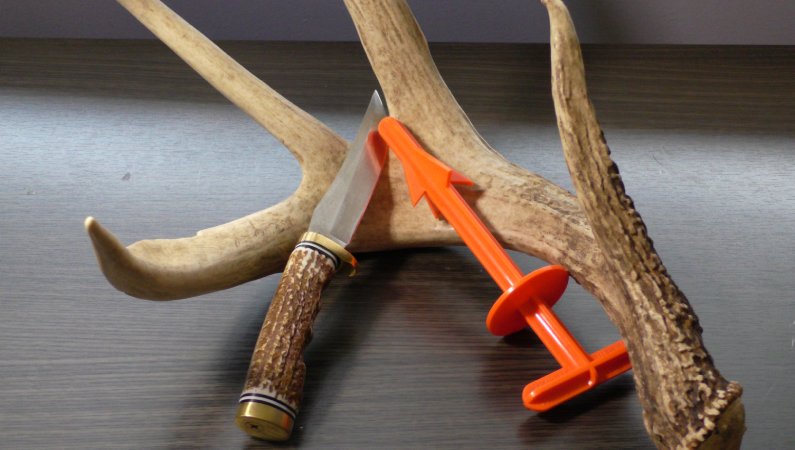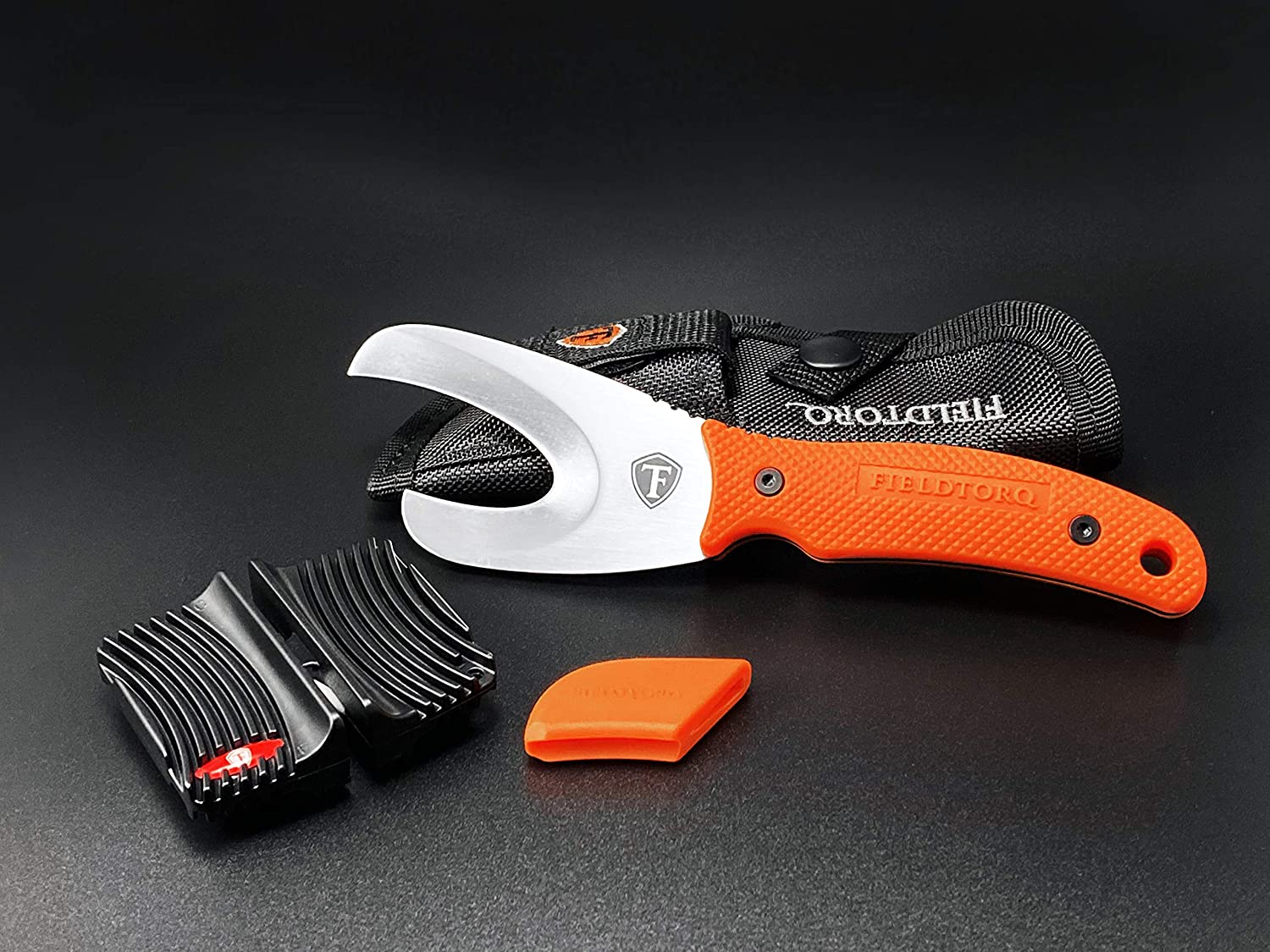The deer gut knife is an indispensable tool for any hunter. In this comprehensive guide, we’ll explore the different types of deer gut knives, their anatomy, and the techniques for using them effectively. We’ll also cover the importance of care and maintenance, safety considerations, and ethical implications of deer gutting.
Deer Gut Knife Types


Choosing the right deer gut knife is crucial for efficient and hygienic field dressing. Various types of gut knives are available, each with specific features and purposes.
The primary types of deer gut knives include:
Fixed Blade Knives, Deer gut knife
- Advantages:Sturdy, reliable, and precise cuts.
- Disadvantages:Less portable, requires a sheath.
Folding Blade Knives
- Advantages:Compact, portable, and convenient to carry.
- Disadvantages:May not be as sturdy as fixed blades, potential for blade play.
Gut Hook Knives
- Advantages:Specialized for opening the deer’s abdominal cavity, reduces the risk of puncturing internal organs.
- Disadvantages:Limited use for other tasks, may require additional knives for field dressing.
Combination Knives
- Advantages:Versatility, combines a gut hook with a traditional blade.
- Disadvantages:May compromise the effectiveness of both the gut hook and the blade.
Anatomy of a Deer Gut Knife
Deer gut knives are specially designed for the efficient removal of a deer’s internal organs during field dressing. They feature unique blade shapes and handle designs that optimize performance and safety. Understanding the anatomy of a deer gut knife is crucial for proper use and maintenance.
Blade
The blade of a deer gut knife is typically thin and flexible, allowing for precise cuts without damaging the internal organs. It is usually curved, facilitating easy maneuvering within the deer’s body cavity. The blade’s sharpness is essential for clean and efficient gutting.
Handle
The handle of a deer gut knife provides a secure and comfortable grip during use. It is often made of non-slip materials to prevent the knife from slipping out of the hand. The handle’s shape and size should fit the user’s hand comfortably, reducing fatigue and enhancing control.
Guard
The guard is a metal or plastic piece located between the blade and the handle. It prevents the user’s hand from slipping onto the blade during use, ensuring safety and preventing injuries.
Importance of Proper Knife Design
The proper design of a deer gut knife is essential for efficient gutting. A thin, flexible blade allows for precise cuts, while a curved shape facilitates easy maneuvering. A non-slip handle provides a secure grip, reducing fatigue and enhancing control.
The guard prevents accidents by keeping the user’s hand away from the blade. These design elements work together to make deer gut knives specialized tools for the safe and efficient removal of a deer’s internal organs.
Techniques for Gutting a Deer


Gutting a deer is a crucial step in the field dressing process, and it requires proper technique to ensure a clean and efficient operation. Experienced hunters have developed various techniques to effectively remove the internal organs while preserving the quality of the meat.
This guide will provide a step-by-step process for gutting a deer, along with detailed instructions and safety precautions.
A deer gut knife is a crucial tool for any hunter, especially when it comes to field dressing your kill. Speaking of impressive kills, did you know about the biggest deer killed in Wisconsin? Check out the details here . A sharp and sturdy deer gut knife is essential for a clean and efficient field dressing, ensuring the quality of your venison.
It’s an indispensable companion for any successful hunting trip.
Step 1: Preparation
Before starting the gutting process, it is essential to prepare the deer and the work area. Hang the deer by its hind legs to allow gravity to assist in the removal of the organs. Gather the necessary tools, including a sharp gutting knife, gloves, and a clean tarp to place under the deer to catch any fluids or debris.
Step 2: Opening the Abdominal Cavity
Using the gutting knife, make an incision along the midline of the abdomen, starting from the pelvic bone and extending towards the chest cavity. Be careful not to cut too deeply and damage the internal organs. Once the incision is made, insert your fingers into the cavity and gently pull the intestines and other organs out.
Step 3: Removing the Intestines
Carefully remove the intestines from the abdominal cavity, working from the pelvic end towards the chest. Sever the mesentery, which is the connective tissue that holds the intestines in place, using the knife. Avoid cutting the intestines as this can release harmful bacteria.
Once the intestines are removed, place them in a separate container for disposal.
Step 4: Removing the Liver and Heart
Locate the liver, which is a large, dark-colored organ on the right side of the cavity. Carefully cut around the liver to detach it from the surrounding tissues. Remove the liver and place it in a separate container. Next, remove the heart by cutting around the base and detaching it from the major blood vessels.
Place the heart in the same container as the liver.
Step 5: Removing the Stomach and Esophagus
Locate the stomach, which is a large, sac-like organ on the left side of the cavity. Cut around the stomach to detach it from the esophagus and other organs. Remove the stomach and place it in a separate container. Then, cut the esophagus and remove it from the deer’s body.
Step 6: Cleaning the Cavity
Once all the organs have been removed, it is important to clean the abdominal cavity thoroughly. Use a damp cloth or sponge to wipe away any remaining blood, fluids, or debris. This will help prevent spoilage and contamination of the meat.
Care and Maintenance of Deer Gut Knives


Proper care and maintenance of deer gut knives are crucial for their longevity and effectiveness. Neglecting these aspects can compromise the knife’s performance, hygiene, and safety. Regular cleaning, sharpening, and proper storage ensure the knife remains in optimal condition for successful deer gutting.
Cleaning Deer Gut Knives
Cleaning the knife promptly after use is essential to prevent rust, bacteria growth, and unpleasant odors. Rinse the knife thoroughly with clean water to remove any blood, tissue, or debris. Use a mild dish soap and a soft sponge or brush to gently scrub away any remaining residue.
Rinse again with clean water and dry the knife thoroughly with a clean cloth or paper towels.
Sharpening Deer Gut Knives
A sharp knife is essential for clean and efficient gutting. Sharpen the knife regularly using a sharpening stone or a honing steel. Start by holding the knife at a 15-20 degree angle to the sharpening stone and gently move it back and forth in a circular motion.
Repeat on the other side of the blade. For honing, use a honing steel and hold the knife at a 20-25 degree angle. Gently draw the knife along the steel in a smooth, sweeping motion.
When you’re out deer hunting, it’s important to have the right gear. That includes a good deer gut knife. A good deer gut knife will make it easy to field dress your deer and get it ready for the table.
But what’s the best straight walled cartridge for deer hunting? There are a lot of different options out there, so it can be tough to decide. This article can help you make the right choice. Once you’ve got the right cartridge, you’ll be able to take down your deer with confidence.
Storing Deer Gut Knives
Proper storage protects the knife from damage and prevents rust. Store the knife in a dry, well-ventilated area, away from moisture. Consider using a knife sheath or a knife block to protect the blade from nicks and scratches. Apply a thin layer of oil to the blade to prevent rust.
Safety Considerations: Deer Gut Knife
Deer gut knives are sharp tools, and their improper use can lead to serious injuries. Therefore, it is crucial to prioritize safety when handling these knives.
Potential Hazards and Risks
Using deer gut knives involves several potential hazards and risks, including:
- Cuts and lacerations: The sharp blade of the knife can easily cause deep cuts or lacerations if not handled carefully.
- Punctures: The pointed tip of the knife can puncture the skin or internal organs if not used properly.
- Slips and falls: The slippery nature of a deer’s internal organs can cause the knife to slip, leading to falls or other accidents.
- Infection: If the knife is not properly cleaned and disinfected, it can introduce bacteria into the deer’s carcass, potentially contaminating the meat.
Guidelines for Safe Knife Use and Storage
To prevent accidents and ensure safe knife use, follow these guidelines:
- Always keep the knife sharp: A sharp knife is less likely to slip and cause injuries.
- Use the knife for its intended purpose only: Deer gut knives are specifically designed for gutting deer and should not be used for other tasks.
- Hold the knife securely: Grip the knife firmly with a non-slip grip, keeping your fingers away from the blade.
- Cut away from yourself: Always cut away from your body to prevent accidental self-inflicted injuries.
- Store the knife properly: When not in use, store the knife in a safe and secure location, out of reach of children and pets.
Ethical Considerations
Deer hunting and gutting raise ethical considerations that require thoughtful reflection and adherence to responsible practices. It’s imperative to respect the animal, minimize its suffering, and ensure the ethical use of wildlife resources.
Respecting the Animal
Ethical hunters prioritize the humane treatment of deer. This involves using sharp, well-maintained knives for a clean and swift kill. It also entails avoiding excessive wounding or unnecessary pain. Additionally, it’s important to handle the deer with care during the gutting process, treating it with the same respect accorded to any other living creature.
Legal Regulations
Navigating the legal landscape surrounding deer gutting is crucial for responsible hunting practices. Different jurisdictions have varying regulations, and understanding these laws ensures compliance and ethical behavior.
Adhering to local regulations is paramount to avoid legal repercussions. These regulations typically encompass:
Knife Use
- Specific knife types may be prohibited or restricted.
- Blade length limitations or design specifications might apply.
- Carrying concealed knives may require a permit or be prohibited.
Hunting Seasons
- Hunting seasons for deer are strictly regulated.
- Hunting outside designated seasons is illegal.
- Bag limits and possession limits may be imposed.
Animal Disposal
- Proper disposal of deer carcasses is mandatory.
- Wasteful or negligent disposal may result in penalties.
- Specific disposal methods, such as rendering or composting, may be required.
Staying informed about local regulations and adhering to them is essential for ethical hunting and legal compliance.
Conclusive Thoughts


Whether you’re a seasoned hunter or just starting out, understanding the ins and outs of deer gut knives will help you make the most of your hunting experience. So, grab your knife and let’s get gutting!
Question Bank
What is the best type of deer gut knife?
The best type of deer gut knife depends on your individual preferences and hunting style. Fixed-blade knives are more durable, while folding knives are more compact. Ultimately, the most important factor is to choose a knife that is sharp and comfortable to use.
How do I clean a deer gut knife?
After each use, it’s important to clean your deer gut knife thoroughly. Use hot water and soap to remove any dirt or debris. You can also use a disinfectant to kill any bacteria. Once the knife is clean, dry it completely and apply a thin layer of oil to prevent rust.
How often should I sharpen my deer gut knife?
The frequency with which you need to sharpen your deer gut knife depends on how often you use it. If you’re using it regularly, you may need to sharpen it every few uses. You can use a whetstone or a sharpening steel to sharpen your knife.







